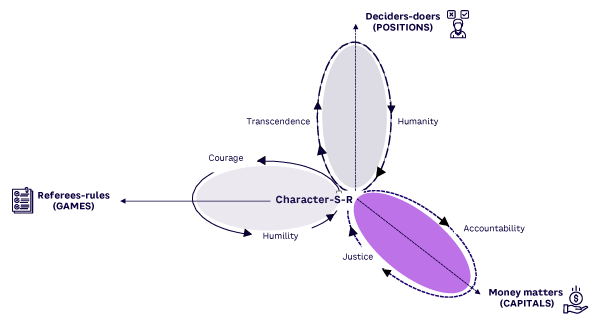Many CEOs are no longer uttering the letters E-S-G. Larry Fink, CEO of BlackRock, confessed, “In my last CEO letter, the phrase ESG was not uttered once, because it’s been unfortunately politicized [and] weaponized. Our business was hurt. We lost $4 billion because of 90% misinformation.”
How do CEOs lead in the eye of the ESG (environment, social, and governance) storm? Silently, perhaps. One thing is certain: their character and judgment are tested as they face the tensions, trade-offs, and dilemmas of ESG while making decisions that impact the prosperity and sustainability of our future.
In this Advisor, we illustrate how today’s frames affect tomorrow’s leaders and leadership. Our work is based on a series of executive conversations designed to explore the influence and impact of leaders’ character on corporate social responsibility (CSR).
Through three North Atlantic roundtables, hosted by the Ian O. Ihnatowycz Institute for Leadership at the Ivey Business School and The Long Run Institute (both located in Canada), we engaged with more than 50 top executives from a variety of sectors to explore leadership in the eye of the ESG storm.
We learned that top leaders tend to construct their ESG strategies through the lenses or frames of Games (with referees and rules), Positions (with some being deciders and some doers), or Capitals (with money overpowering other capitals). Simply put, ESG strategies are neither given nor static. Rather, they evolve depending on the character dimensions of the leaders who envision and enact them (see Figure 1).

Although character is a holistic construct of 11 interconnected dimensions (or virtues), we found that each frame elevates two character dimensions into a unique and dynamic tension: courage and humility, transcendence and humanity, justice and accountability. By living and leading amid these inner tensions, leaders evolve what CSR means to them, their boards, and their stakeholders. Elevating character compels many top leaders to radically rework ESG.
Through the roundtables, we caught a rare glimpse at how leaders connect their inner and outer worlds as they brace for increasingly polarized CSR. We discussed the three lenses and learned that although the future of CSR may no longer explicitly contain the letters ESG, it is more purposeful than ever. Today’s leaders can make tomorrow more responsible by turning inward and taking social responsibilities personally as they “triple down” on purpose.
We call our framework Character-S-R to underscore that beneath every compelling commitment to ESG, there are deeply felt aspects of who one is and how one aims to show up as a leader. Strong, well-developed character is critical to any individual’s performance, judgment, and success (in any job, at any level), but top leaders are often held to a higher standard. We expect those who safeguard our futures, feed our children, or invest our money to be of virtuous character. Departures from virtuous behaviors tend to be more visible at the top, too. What is often missed are the connections between who a leader is and how one leads. In the eye of the ESG storm, such connections cannot be taken for granted.
[For more from the authors on this topic, see: “Leading in the Eye of the ESG Storm.”]





